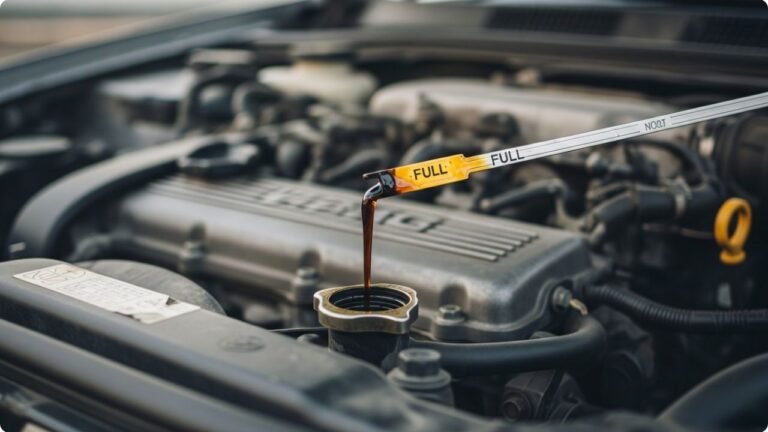How Long Does a Car Engine Oil Change Take?

If you’ve ever sat in your car, sipping coffee at a garage, wondering how long this whole oil change process would take, you’re not alone. It’s something every car owner deals with. The wait can feel like forever—especially when you’re in a rush or have a long to-do list. But how long should it take, really?
Let’s get into the details about car engine oil Change Duration—what it really means, how it varies, and what factors can influence it. Whether you’re doing it yourself or heading to a mechanic, this guide breaks it down in the most relatable way possible. We’re not just talking numbers—we’re getting into the nitty-gritty that every car lover (or casual driver) should know.
What Is Meant by “Car Engine Oil Change Duration”?

Now, that’s the general rule of thumb, but it’s not a one-size-fits-all kind of thing. Think of it like your dentist telling you to brush twice a day. Yes, it’s standard advice, but you might need to adjust based on your lifestyle, habits, and car type.
Some quick facts to give you perspective:
- Most modern vehicles use synthetic oil which lasts longer.
- Older vehicles or high-mileage engines might need more frequent changes.
- Driving conditions like dust, heat, or heavy loads can impact duration.
So when someone mentions car engine oil Change Duration, they’re referring to that commonly accepted 5-month or 5,000-mile interval. But as we’ll see in the next sections, there’s more to it than just numbers.
Why Changing Your Engine Oil Matters More Than You Think
Changing your engine oil isn’t just maintenance—it’s your car’s version of a health check-up. Think of oil as the lifeblood of your engine. It keeps things cool, reduces friction, and ensures that all those metal parts glide smoothly. If you skip oil changes, you’re asking for trouble. It’s like running a marathon with no water—your engine will eventually break down.
Here’s what happens when you skip or delay oil changes:
- Engine wear and tear increases drastically.
- Your fuel efficiency drops.
- The engine can overheat, or worse, seize up.
- Dirty oil turns into sludge, which is toxic for your engine.
I remember once delaying an oil change by three months. The car started vibrating at stoplights, and the engine light popped on. When I finally went in, the mechanic showed me this thick, black goo he drained out. It was like molasses! Not good.
Trust me—timely oil changes are a small price to pay for long-term reliability.
What Actually Happens During an Oil Change?
You might think an oil change is just about draining and refilling oil, but it’s a bit more detailed than that. A standard oil change process typically includes the following steps:
| Step | Task Description |
| 1 | Draining old engine oil |
| 2 | Removing the old oil filter |
| 3 | Replacing with a new oil filter |
| 4 | Adding fresh, clean oil |
| 5 | Checking oil level and condition |
In most service shops, this takes around 20 to 45 minutes, depending on how busy the place is and what kind of car you drive. DIY oil changes can take longer, especially if it’s your first time. I’ve spent over an hour on mine before, just because I couldn’t loosen the oil filter—it was like wrestling with a bear.
But once you get the hang of it, it becomes second nature.
So when someone asks about car engine oil Change Duration, this table gives a real-world picture of the steps involved in that timeframe.
What Influences Car Engine Oil Change Duration?
Just like cooking times differ based on the recipe, the oil change duration depends on a bunch of factors. These little things can make a big difference:
- Car make and model: Some cars are easier to work on than others.
- Engine type: Diesel engines may take longer than gasoline ones.
- Oil type: Synthetic oil flows easier and may take less time to drain.
- Service type: Quick-lube stations are faster than full-service garages.
- Mechanic’s experience: A skilled hand gets it done faster and cleaner.
One time, I drove my buddy’s old Jeep into a quick-lube center, and the guy said, “This one’s gonna take longer—tight filter placement.” Turns out, older Jeeps have filters hidden in the weirdest spots.
So, while car engine oil Change Duration sounds like a fixed figure, it actually bends and shifts depending on what you drive and how you treat it.
The Role of Synthetic vs. Conventional Oil in Change Intervals
Let’s talk about synthetic oil versus conventional oil—because this choice impacts both your car’s health and how often you need to change the oil.
Synthetic Oil:
- Lasts longer (up to 7,500 to 10,000 miles).
- Flows better at low and high temps.
- Costs more upfront, but saves money in the long run.
- Cleaner, with fewer impurities.
Conventional Oil:
- Cheaper, more widely used in older vehicles.
- Needs changing every 3,000 to 5,000 miles.
- Breaks down faster under heat and stress.
So, if you’re using synthetic oil, your car engine oil Change Duration guideline can often be extended safely. But with conventional oil, it’s smart to stick closer to that 5,000-mile mark or even sooner if you drive hard.
My mechanic once said, “Synthetic is like a smoothie for your engine. Conventional is like soda. It works, but long-term… not the healthiest.”
How Driving Habits Can Affect Oil Change Frequency
Driving habits play a huge role in how often you need an oil change. You and I could drive the same car, but if you’re zipping down the freeway and I’m stuck in bumper-to-bumper city traffic, our oil wears differently.
Let’s look at some common habits that shorten the car engine oil Change Duration cycle:
- Short trips (under 5 miles): The engine doesn’t warm up enough to burn off moisture.
- Stop-and-go driving: Constant idling heats up oil faster.
- Towing or hauling heavy loads: Puts extra strain on the engine.
- High-speed driving: More engine heat, more oil breakdown.
It’s all about heat and stress. The more pressure you put on your engine, the faster your oil wears out.
Think of your engine oil like your phone battery. Heavy usage drains it faster. So even if the calendar says you’re still within five months, your oil might already be crying for help.
DIY vs. Professional Oil Change: Time and Cost Comparison
When it comes to getting your oil changed, you’ve got two clear paths: do it yourself or head to a professional service center. Both have their pros and cons, and interestingly, they both affect the total car engine oil Change Duration in different ways.
DIY Oil Change
If you’re the hands-on type, doing it yourself can be rewarding. You get to know your car better, save some cash, and feel that sense of accomplishment. But it’s not always quick. Your first DIY oil change can easily stretch to an hour or more. There’s the setup, the mess, and the disposal of used oil to think about.
Professional Oil Change
Professionals have speed and skill. Quick-lube shops can get the job done in under 30 minutes. Full-service garages might take longer but often include checks on air filters, tire pressure, and fluid levels. You pay more, but you’re paying for convenience and expertise.
| Method | Time Taken | Average Cost | Pros | Cons |
| DIY | 45-90 mins | $25-$45 | Saves money, educational | Messy, time-consuming |
| Professional | 20-45 mins | $50-$100 | Fast, clean, reliable | Costs more |
So, when considering car engine oil Change Duration, ask yourself: “Is my time worth more than the money I’d save?”
Signs You Shouldn’t Wait for the 5-Month or 5,000-Mile Mark
Here’s the thing—car engine oil Change Duration is a general recommendation, not a hard rule. Sometimes, your car talks to you. Well, not literally—but it shows signs that it’s time for fresh oil, even before hitting that 5-month or 5,000-mile point.
Keep an eye (and ear) out for these signals:
- Oil warning light on your dashboard
- Knocking or grinding sounds from the engine
- Dark, thick, or gritty oil on the dipstick
- Exhaust smoke (especially blue or gray)
- Rough idling or lower fuel economy
I once ignored the early signs—thinking, “I’ve got another 1,000 miles, I’m good.” Bad move. The engine ran hot, and I had to replace a gasket. Lesson learned.
Trust your car’s behavior as much as the mileage. If it seems off, don’t wait for the clock to hit five.
Tips to Help Extend Engine Life Between Oil Changes
While you shouldn’t stretch your oil change intervals too far, there are smart driving habits that can help your oil last longer. These also support the idea behind the car engine oil Change Duration by keeping your engine in better shape over time.
Here are a few tricks to get the most out of your oil:
- Warm up your engine before driving off, especially in winter.
- Avoid short trips when possible—combine errands to let the engine fully warm.
- Stick to smooth acceleration and braking—aggressive driving breaks down oil faster.
- Use high-quality oil that suits your engine’s specs.
- Keep your engine clean—a dirty engine contaminates oil quicker.
Think of your oil like a kitchen sponge. If you abuse it, it wears out faster. But if you use it wisely and cleanly, it lasts longer. Good habits make a difference.
What Does an Oil Change Cost You—Really?
Now let’s talk numbers. People often ask, “Is it worth it to change oil so often?” The short answer: absolutely. Compared to engine repair costs, an oil change is practically pocket change.
Here’s a quick breakdown:
| Oil Type | Average Cost (DIY) | Average Cost (Professional) | Interval |
| Conventional | $25–$35 | $40–$70 | 3,000–5,000 miles |
| Synthetic Blend | $35–$45 | $60–$80 | 5,000–7,000 miles |
| Full Synthetic | $45–$65 | $75–$120 | 7,500–10,000 miles |
Skipping oil changes to save $50 can cost you $3,000 to $5,000 down the line if your engine needs major repairs. It’s like skipping dentist visits—you might save now, but pay painfully later.
So while car engine oil Change Duration may seem frequent, it’s actually a sweet spot between cost and care.
Cultural Shift: Why Engine Oil Habits Vary by Region
It’s fascinating how engine oil change habits differ based on where you are. In the U.S., the 3,000 to 5,000-mile rule is still widely followed. But in parts of Europe or Japan, drivers often wait until 10,000 miles, thanks to advanced engines and better synthetic oils.
Here in the U.S., we have more extreme temperatures, longer commutes, and bigger engines. That affects how fast oil degrades. In rural Texas, for example, dusty conditions make oil dirty faster. In a city like New York, stop-and-go traffic adds heat and stress.
This is why car engine oil Change Duration feels right for many American drivers—it balances lifestyle, road conditions, and engine needs.
I grew up in the Midwest, and every 5,000 miles, my dad would say, “Time to treat the engine right.” It was like a family ritual. It stuck with me, and now I even mark it in my calendar.
Final Thoughts: Make Oil Changes a Habit, Not a Hassle
Let’s be honest—no one loves sitting in a garage waiting room. But oil changes don’t have to be a chore. With a little planning, they become just another part of caring for your ride, like washing it or topping off the wiper fluid.
The car engine oil Change Duration guideline is like brushing your teeth—it might not be exciting, but it keeps the engine smiling. And when your car runs smooth, it shows love back with fewer breakdowns, better mileage, and longer life.
Next time you see that sticker on your windshield reminding you it’s time, don’t roll your eyes. Smile a little. You’re keeping your engine young.
Just like friendships or health, your car needs regular care. So don’t wait for smoke or weird noises. Be proactive. Treat oil changes not as a task, but as a tiny ritual of respect.





